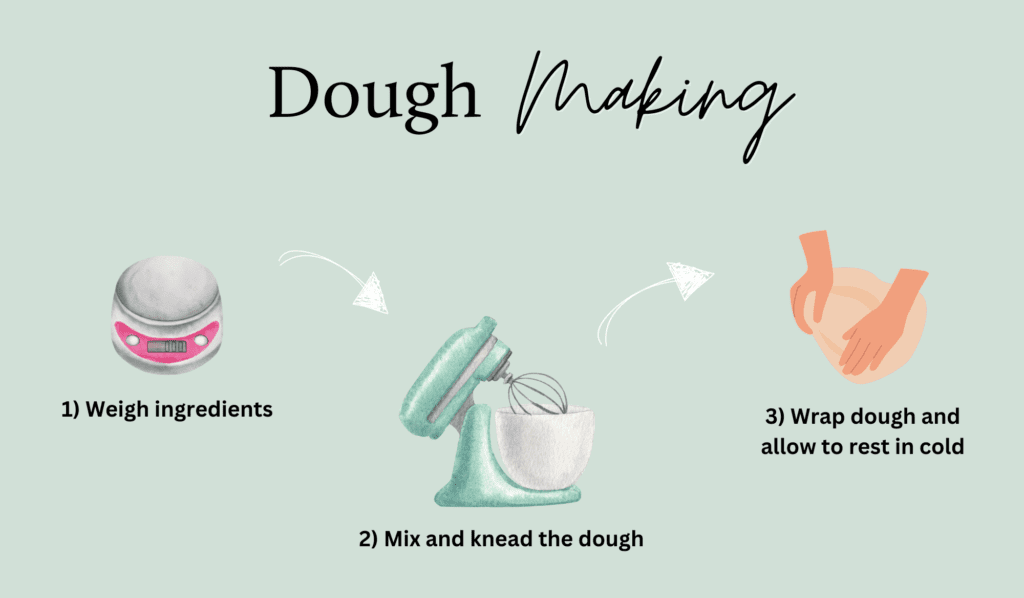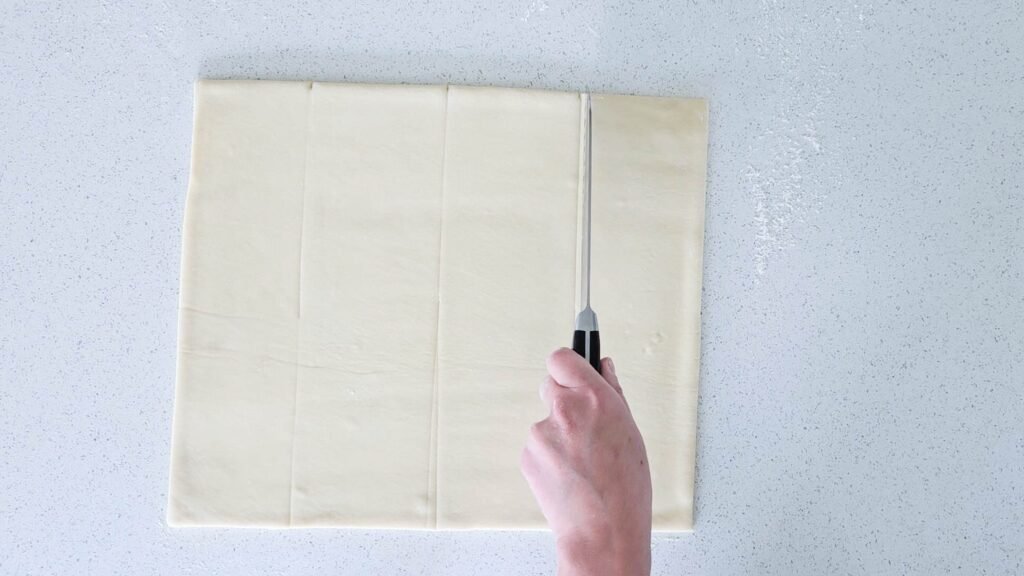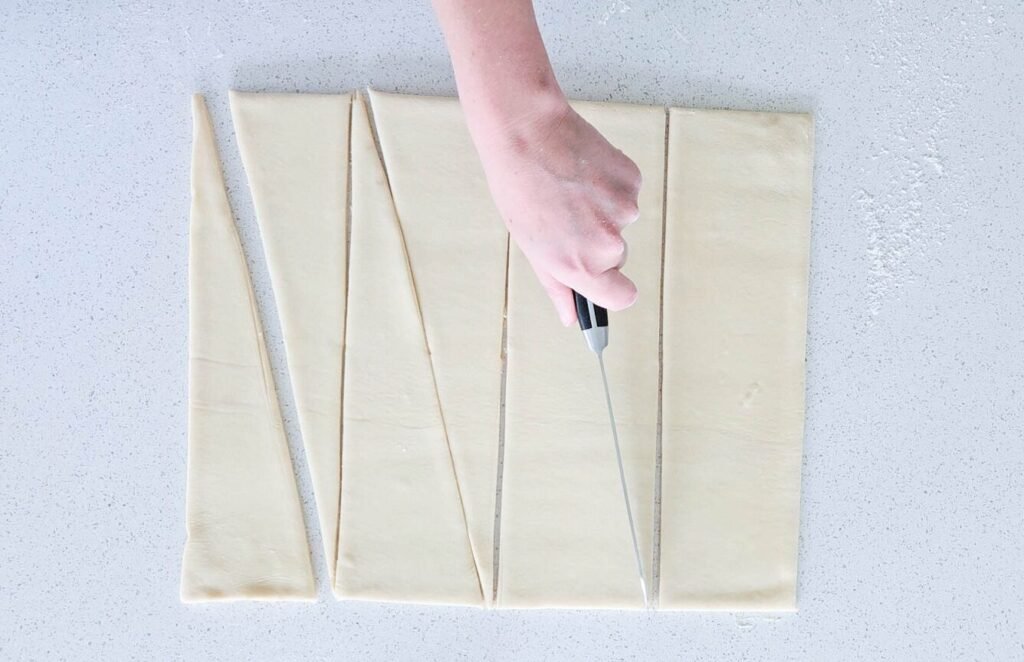After trying to make these homemade croissants, you will never...
Before we get started...
I've taught thousands of homebakers...
Summary of the Croissant Making Process




The process consists of 4 stages
What is laminating?
How long does it take to complete the 4 stages?
Can you stop and freeze at any point of the process?
How long can the dough be in the freezer for?
The 2 most important concepts throughout the process
- Controlling the temperature of the dough. This will protect the butter layers.
- Allowing the dough to rest in the refrigerator. This will allow the gluten to relax, and the butter to remain cold.
Frequently Asked Questions
Not at all, the tools we will be using are: a rolling pin, measuring tape, large baking tray, parchment paper and a sharpie pen. I also do recommend using a standing mixing, with a dough hook.
Regarding ingredients you will be using: all purpose flour, water, whole milk, salt, sugar, instant yeast, salt and European unsalted butter.
Please make sure you splurge on European butter… it makes a big difference! not only in flavor, but in how easy it will be to work with the layers of butter.
There are 2 important concepts that you should remember at all times during the process.
- The first one is, controlling the dough’s temperature.
- The second one, allowing the dough to rest (in cold temperatures) for the gluten to relax.
It just depends on how many stages of the process you decide to do in a day. At a minimum, this process can be done in 2 days. The physical or hands on labor covers about a 4 hour span. Otherwise, letting the dough rest in between the different stages as well as the proofing stage are what take the most time.
Remember that in between any of the 4 stages, you can freeze the dough.
The only time you CANNOT freeze the dough is when the croissants have been proofed and are ready to be baked.
No, because croissant making is like everything else in life, the more you practice the better you will get at it. The first time you attempt making croissants you should try to focus on understanding the process and the variables that affect it. You also need to pay attention to your rolling technique (we will get into those details on how to roll the dough later).
Because when making bread and especially croissants being precise is key.
Please do not substitute ANY of the ingredients in this recipe. Each ingredient serves a purpose and any changes made affect the outcome.
Because when laminating the dough (creating the layers) you will be rolling to a specific length and width. Those measurements will guarantee the desired thickness of the dough. This is where your mathematical skills will come into play.
Let's Get Ready
1. Ingredients
1.1. Ingredients for the Dough
- All purpose flour
- Water
- Whole milk
- Salt, fine
- Sugar
- Instant yeast
- European unsalted butter


1.2. Ingredients for lamination

2. Tools
- Kitchen digital scale
- Stand mixer, dough hook attachment
- Rolling pin
- Measuring tape
- Large baking tray
- Food plastic wrap
- Chef knife
- Parchment paper
- Pastry brush


Let's Start
Stage 1 - Dough Making

Dough Making - 3 Steps

1.1 Weigh the Ingredients

1.2 Mix and Knead the Dough

1.3 Dough Resting



Stage 2 - Lamination

1) Prepare butter block
2) Shape the dough
3) Enclose butter
4) Double fold
5) Single fold
2.1 Prepare the Butter Block
Step 1 - Shape Parchment Paper

Step 2 - Chop Butter and Assemble


Step 3 - Pound Butter & Roll









2.2 Shape the Dough

2.3 Enclose the Butter




2.4 Roll & Double Fold





2.5 Roll & Single Fold





Stage 3 - Shaping

1) Roll to 14x17
2) Cut rectangles
3) Roll
4) Proof
Step 1 - Roll to 14''x17''




Step 2 - Cut rectangles


Step 3 - Cut triangles & shape








Stage 4 - Proof & Bake

4.1 Proof
How to proof croissants...
- Putting the tray inside a large plastic bag, or covering them with a large piece of plastic wrap. The bag/wrap cannot touch the croissants, so you will need to place something inside to create a space between the bag/wrap and the dough (wine classes are great option).
- Boil water, put in a small container, and place it inside your oven, with the tray. That will give some humidity which will help the dough from not creating a dry skin.
If you have a proofing setting in your oven...
How long will it take for the croissants to be ready to bake...


4.2 Bake
How to egg wash & bake




How to store croissants

Homemade Croissants
Equipment
- Kitchen digital scale
- Stand mixer dough hook
- Rolling Pin at least 9 inches long
- Measuring tape
- Baking tray, large
- Chef knife
- Parchment Paper
- Pastry brush
- Food plastic wrap
Ingredients
Dough Ingredients
- 605 grams All purpose flour
- 214 grams Water cold
- 120 grams Whole milk
- 12 grams Salt fine
- 66 grams Sugar white
- 7 grams Instant yeast
- 55 grams Unsalted butter
Lamination Ingredients
- 330 grams Unsalted butter european
Instructions
Dough Making
- Weigh ingredients.It is important to use a digital scale to get good results. Using your kitchen digital scale you will start by weighing each ingredient separately. Remember you will be using GRAMS, so please check that your scale is set to the correct unit of measurement. Do not try to convert grams to volume size measurement (cups and spoons).
- Mix the dough.Place the liquid ingredients (water and milk) in the bowl of your standing mixer. Then, add the dry ingredients: all purpose flour, sugar, instant yeast and salt. For now, leave the butter aside, as you will add it later in the process. Remember the butter should be cold (but not frozen) so leave it on your kitchen counter at room temperature during the mixing process (only if your kitchen is not over 75°F).You will start mixing the dough on low speed and as the ingredients gradually combine you will need to turn the speed up to medium high. Also, never walk away from your standing mixer while it is on.Mix the dough for 10 minutes. The goal is that all the ingredients are combined and that you are not able to identify them separately in the dough.At this point, cut your butter up into a few pieces. You can now slowly start adding the pieces of butter in. If you have 5 pieces of butter, add 1, wait until it combines (in the mixer) with the dough and repeat the same process for each piece.You will stop mixing the dough once all the butter has been well incorporated into the dough.
- Allow the dough to rest.An important part of making croissants, is ensuring the dough is cold at all times cold and relaxed (by that I mean the gluten and yourself!). Once your dough is mixed, take it out of the mixing bowl, wrap it in plastic and using your hands or a rolling pin, flatten the dough out into a rough square (measuring no more than 8" on one side). Using a sharpie label the dough and then, place it in the freezer for 30 minutes. The goal here is to the get the dough cold the quickest way. Then, transfer the dough to the refrigerator for at least 12 hours and maximum 24 hours.
Lamination
- Lamination is the part of the process in which you create the layers in a croissant. Make sure to watch the below video with some important concepts you will need to have in mind throughout the entire lamination process.
- Prepare the Butter Block
- Shape the Dough
- Enclose the Butter
- Double fold
- Single fold
Shaping
- Roll to 14''x17''
- Cut rectangles 4'' base
- Cut triangles & shape
Proofing and Baking
Storing
- Store your baked croissants in an airtight container or a ziploc bag! In the refrigerator for upto 7 days. They are best within 24 hours.







Hello,
For the Layering Process, Shaping, Baking, you say to download your step by step guide below. However, i din’t see it. Can you please advise.
Thank you,
Rosi
Hi Rosi, the recipe has been fully updated! you should be all good to try making croissants now 🙂
Great recipe and instructions! I never had much luck making croissants. This recipe had great step by step directions that helped me achieve flaky layers of buttery goodness! So yummy! Croissants are a labor of love but this recipe makes it worth it! Thanks Javi!
Michelle, I’m so excited to see you were able to make them successfully! Your croissants look PERFECT! 🙂